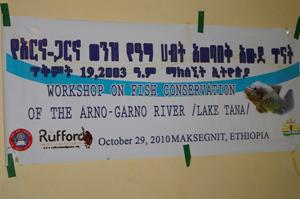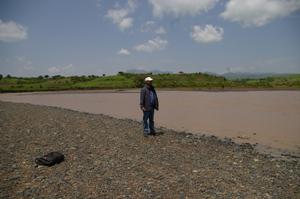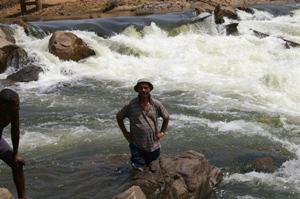Abebe Getahun
Other projects
13 Jul 2011
Conserving the Labeobarbus Spp Flock of Lake Tana through Better Understanding of their Migratory Behaviour and Participation of the Community: The Case of Gilgel Abay River
30 Jan 2013
The Impact of Sand Mining and Irrigation Canals on the Spawning Migration of Labeobarbus spp. of Lake Tana and Possible Mitigation Measures
To enhance the conservation of the only remaining cyprinid species flock of Labeobarbus spp. through concerted efforts of ecological studies and active participation of the community.
Lake Tana is Ethiopia’s largest lake and is situated in the north-western highlands at an altitude of about 1800 m. and it forms the headwaters of the Blue Nile River. The lake emerged as one of the global top 250 lake regions most important for biological diversity. Its uniqueness lies on the fish species that inhabit this lake. There are 28 species of fish out of which 21 are endemic to the country. They are included within the genera Barbus, Clarias, Garra, Labeobarbus, Nemacheilus, Oreochromis and Varicorhinus. The most significant genus is Labeobarbus consisting of 17 species, forming a species flock, the only remaining cyprinid species flock in the world after the ones in Lake Lanao, Philippines, have decimated.

It is known that some of these fishes migrate to tributary rivers to breed during the rainy seasons. So far, only seven species are known to migrate and spawn in the rivers. The spawning grounds of the remaining 10 species are not well studied and whether or not all the tributary rivers serve as breeding grounds is not fully known. Some of the species are very scarce and were proposed as endangered species for IUCN Red listing. Data about the ecology of the juveniles, which return to the lake after hatching in the rivers, are totally lacking.

On the other hand, there is an increased rate of degradation of the lake, riverine and wetland environments as a result of human activities (dam building, irrigation schemes, overgrazing and human encroachment). There is also an increased and unregulated mass fishing especially during the period of the spawning migration of the fishes.

Past studies, this one and future studies on Labeobarbus spp. of Lake Tana will enable us to understand the breeding behaviour and life history of all or most of these species. Some of the tributary rivers that have not been surveyed for the adult migratory fishes will be studied. The ecology of the juveniles that hatch among the pebbles of tributary rivers will be investigated. The temporal and spatial distribution of the juveniles will be determined. These data are basic and essential for highly needed management strategy and for proper conservation of the Labeobarbus spp.
The awareness that will be created among the fishermen and farmers around Lake Tana will prevent the use of dangerous fishing methods (like using poisonous powder or blocking the water course during the period of their migration for spawning). The policy and decision makers will formulate appropriate regulations for proper implementation of the fishery policy of the Federal and Regional Governments. They will set follow up, evaluation and monitoring mechanisms. Fishermen’s cooperatives will be strengthened to combat unlicensed illegal fishermen, which greatly contributed to the decrease in the stock of the Labeobarbus species.